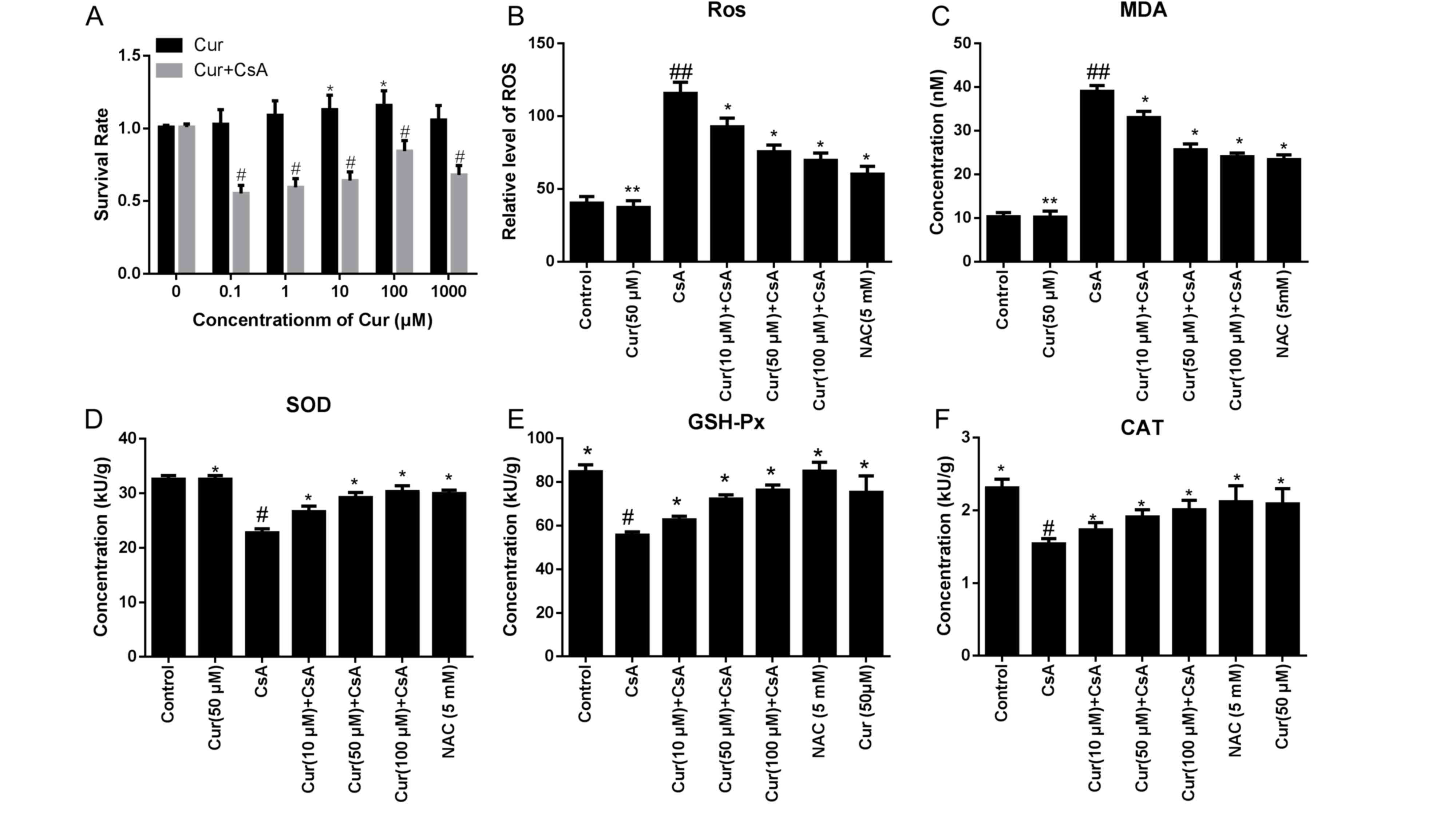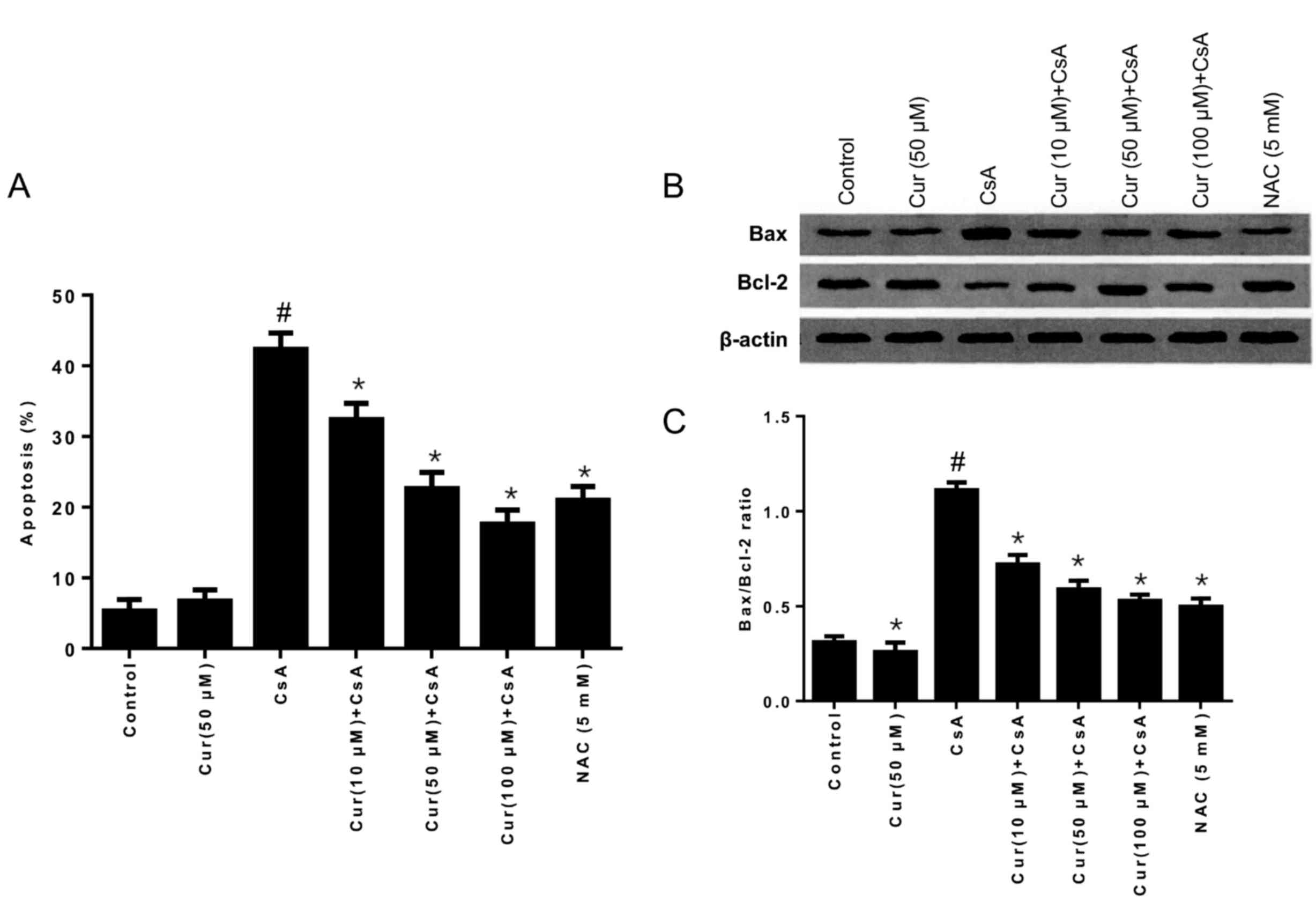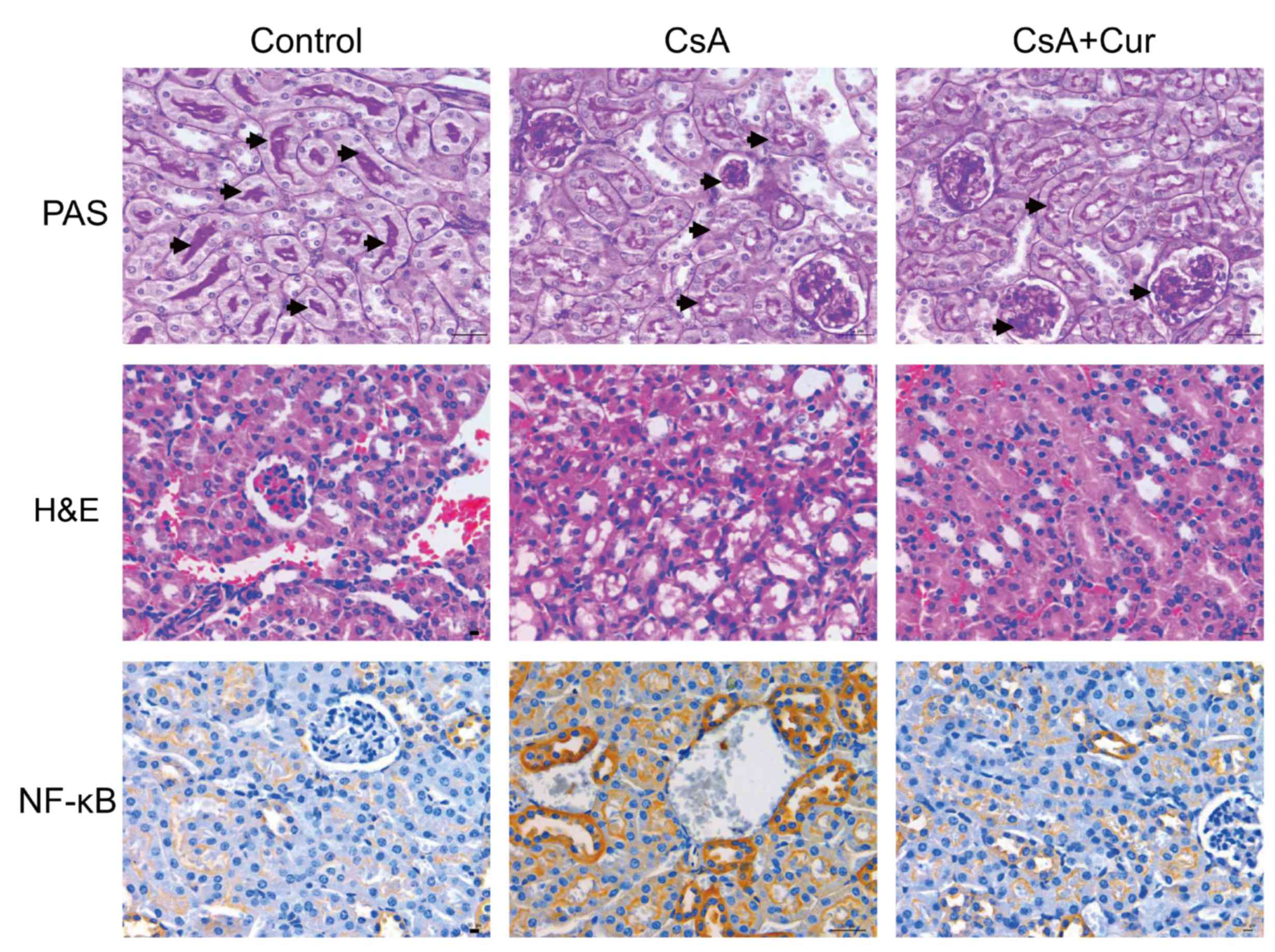|
1
|
Jorga A, Holt DW and Johnston A:
Therapeutic drug monitoring of cyclosporine. Transplant Proc. 36 2
Suppl:pp. 396S–403S. 2004; View Article : Google Scholar : PubMed/NCBI
|
|
2
|
Tedesco D and Haragsim L: Cyclosporine: A
review. J Transplant. 2012:2303862012. View Article : Google Scholar : PubMed/NCBI
|
|
3
|
Zhong Z, Arteel GE, Connor HD, Yin M,
Frankenberg MV, Stachlewitz RF, Raleigh JA, Mason RP and Thurman
RG: Cyclosporin A increases hypoxia and free radical production in
rat kidneys: Prevention by dietary glycine. Am J Physiol.
275:F595–F604. 1998.PubMed/NCBI
|
|
4
|
Pérez de Lema G, Arribas I, Prieto A,
Parra T, de Arriba G, Rodríguez-Puyol D and Rodríguez-Puyol M:
Cyclosporin A-induced hydrogen peroxide synthesis by cultured human
mesangial cells is blocked by exogenous antioxidants. Life Sci.
62:1745–1753. 1998. View Article : Google Scholar : PubMed/NCBI
|
|
5
|
Mariee AD and Abd-Ellah MF: Protective
effect of docosahexaenoic acid against cyclosporine A-induced
nephrotoxicity in rats: A possible mechanism of action. Ren Fail.
33:66–71. 2011. View Article : Google Scholar : PubMed/NCBI
|
|
6
|
Tavares P, Fontes Ribeiro CA and Teixeira
F: Cyclosporin effect on noradrenaline release from the sympathetic
nervous endings of rat aorta. Pharmacol Res. 47:27–33. 2003.
View Article : Google Scholar : PubMed/NCBI
|
|
7
|
Wan Q and Liu ZY: Effect of curcumin on
human umbillcal veln endothellal cell injury induced by lipocalin
2. Chin J Arterioscler. 21:229–233. 2016.(In Chinese).
|
|
8
|
Djamali A, Reese S, Yracheta J, Oberley T,
Hullett D and Becker B: Epithelial-to-mesenchymal transition and
oxidative stress in chronic allograft nephropathy. Am J Transplant.
5:500–509. 2005. View Article : Google Scholar : PubMed/NCBI
|
|
9
|
Shrestha BM and Haylor J: Biological
pathways and potential targets for prevention and therapy of
chronic allograft nephropathy. Biomed Res Int. 2014:4824382014.
View Article : Google Scholar : PubMed/NCBI
|
|
10
|
Maryniak RK, First MR and Weiss MA:
Transplant glomerulopathy: Evolution of morphologically distinct
changes. Kidney Int. 27:799–806. 1985. View Article : Google Scholar : PubMed/NCBI
|
|
11
|
Kang HM, Ahn SH, Choi P, Ko YA, Han SH,
Chinga F, Park AS, Tao J, Sharma K, Pullman J, et al: Defective
fatty acid oxidation in renal tubular epithelial cells has a key
role in kidney fibrosis development. Nat Med. 21:37–46. 2015.
View Article : Google Scholar : PubMed/NCBI
|
|
12
|
Fonseca I, Reguengo H, Almeida M, Dias L,
Martins LS, Pedroso S, Santos J, Lobato L, Henriques AC and
Mendonça D: Oxidative stress in kidney transplantation:
Malondialdehyde is an early predictive marker of graft dysfunction.
Transplantation. 97:1058–1065. 2014. View Article : Google Scholar : PubMed/NCBI
|
|
13
|
Andersen JK: Oxidative stress in
neurodegeneration: Cause or consequence? Nat Med. 10 Suppl:S18–S25.
2004. View
Article : Google Scholar : PubMed/NCBI
|
|
14
|
Priya DK, Gayathri R, Gunassekaran GR and
Sakthisekaran D: Protective role of sulforaphane against oxidative
stress mediated mitochondrial dysfunction induced by benzo(a)pyrene
in female Swiss albino mice. Pulm Pharmacol Ther. 24:110–117. 2011.
View Article : Google Scholar : PubMed/NCBI
|
|
15
|
Wei Y, Clark SE, Thyfault JP, Uptergrove
GM, Li W, Whaley-Connell AT, Ferrario CM, Sowers JR and Ibdah JA:
Oxidative stress-mediated mitochondrial dysfunction contributes to
angiotensin II-induced nonalcoholic fatty liver disease in
transgenic Ren2 rats. Am J Pathol. 174:1329–1337. 2009. View Article : Google Scholar : PubMed/NCBI
|
|
16
|
Evans JL, Goldfine ID, Maddux BA and
Grodsky GM: Oxidative stress and stress-activated signaling
pathways: A unifying hypothesis of type 2 diabetes. Endocr Rev.
23:599–622. 2002. View Article : Google Scholar : PubMed/NCBI
|
|
17
|
Yu JH and Kim H: Oxidative stress and
inflammatory signaling in cerulein pancreatitis. World J
Gastroenterol. 20:17324–17329. 2014. View Article : Google Scholar : PubMed/NCBI
|
|
18
|
Romero F, Herrera J, Nava M and
Rodríguez-Iturbe B: Oxidative stress in renal transplantation with
uneventful postoperative course. Transplant Proc. 31:pp. 2315–2316.
1999; View Article : Google Scholar : PubMed/NCBI
|
|
19
|
Ruiz MC, Moreno JM, Ruiz N, Vargas F,
Asensio C and Osuna A: Effect of statin treatment on oxidative
stress and renal function in renal transplantation. Transplant
Proc. 38:pp. 2431–2433. 2006; View Article : Google Scholar : PubMed/NCBI
|
|
20
|
Vostálová J, Galandáková A, Svobodová AR,
Kajabová M, Schneiderka P, Zapletalová J, Strebl P and Zadražil J:
Stabilization of oxidative stress 1 year after kidney
transplantation: Effect of calcineurin immunosuppressives. Ren
Fail. 34:952–959. 2012. View Article : Google Scholar : PubMed/NCBI
|
|
21
|
Nelson KM, Dahlin JL, Bisson J, Graham J,
Pauli GF and Walters MA: The essential medicinal chemistry of
curcumin. J Med Chem. 60:1620–1637. 2017. View Article : Google Scholar : PubMed/NCBI
|
|
22
|
Gupta SC, Patchva S, Koh W and Aggarwal
BB: Discovery of curcumin, a component of golden spice, and its
miraculous biological activities. Clin Exp Pharmacol Physiol.
39:283–299. 2012. View Article : Google Scholar : PubMed/NCBI
|
|
23
|
Sharma M, Manoharlal R, Puri N and Prasad
R: Antifungal curcumin induces reactive oxygen species and triggers
an early apoptosis but prevents hyphae development by targeting the
global repressor TUP1 in Candida albicans. Biosci Rep. 30:391–404.
2010. View Article : Google Scholar : PubMed/NCBI
|
|
24
|
Rahmani AH, Al Zohairy MA, Aly SM and Khan
MA: Curcumin: A potential candidate in prevention of cancer via
modulation of molecular pathways. Biomed Res Int. 2014:7616082014.
View Article : Google Scholar : PubMed/NCBI
|
|
25
|
Prakobwong S, Gupta SC, Kim JH, Sung B,
Pinlaor P, Hiraku Y, Wongkham S, Sripa B, Pinlaor S and Aggarwal
BB: Curcumin suppresses proliferation and induces apoptosis in
human biliary cancer cells through modulation of multiple cell
signaling pathways. Carcinogenesis. 32:1372–1380. 2011. View Article : Google Scholar : PubMed/NCBI
|
|
26
|
Fujisawa S, Atsumi T, Ishihara M and
Kadoma Y: Cytotoxicity, ROS-generation activity and
radical-scavenging activity of curcumin and related compounds.
Anticancer Res. 24:563–569. 2004.PubMed/NCBI
|
|
27
|
Calabrese V, Bates TE, Mancuso C,
Cornelius C, Ventimiglia B, Cambria MT, Di Renzo L, De Lorenzo A
and Dinkova-Kostova AT: Curcumin and the cellular stress response
in free radical-related diseases. Mol Nutr Food Res. 52:1062–1073.
2008. View Article : Google Scholar : PubMed/NCBI
|
|
28
|
Trujillo J, Chirino YI, Molina-Jijón E,
Andérica-Romero AC, Tapia E and Pedraza-Chaverrí J: Renoprotective
effect of the antioxidant curcumin: Recent findings. Redox Biol.
1:448–456. 2013. View Article : Google Scholar : PubMed/NCBI
|
|
29
|
Pan Y, Wang Y, Cai L, Cai Y, Hu J, Yu C,
Li J, Feng Z, Yang S, Li X and Liang G: Inhibition of high
glucose-induced inflammatory response and macrophage infiltration
by a novel curcumin derivative prevents renal injury in diabetic
rats. Br J Pharmacol. 166:1169–1182. 2012. View Article : Google Scholar : PubMed/NCBI
|
|
30
|
Kim BH, Lee ES, Choi R, Nawaboot J, Lee
MY, Lee EY, Kim HS and Chung CH: Protective effects of curcumin on
renal oxidative stress and lipid metabolism in a rat model of type
2 diabetic nephropathy. Yonsei Med J. 57:664–673. 2016. View Article : Google Scholar : PubMed/NCBI
|
|
31
|
Pang XF, Zhang LH, Bai F, Wang NP, Garner
RE, McKallip RJ and Zhao ZQ: Attenuation of myocardial fibrosis
with curcumin is mediated by modulating expression of angiotensin
II AT1/AT2 receptors and ACE2 in rats. Drug Des Devel Ther.
9:6043–6054. 2015.PubMed/NCBI
|
|
32
|
Huang MT, Lysz T, Ferraro T, Abidi TF,
Laskin JD and Conney AH: Inhibitory effects of curcumin on in vitro
lipoxygenase and cyclooxygenase activities in mouse epidermis.
Cancer Res. 51:813–819. 1991.PubMed/NCBI
|
|
33
|
Shen L and Ji HF: Insights into the
inhibition of xanthine oxidase by curcumin. Bioorg Med Chem Lett.
19:5990–5993. 2009. View Article : Google Scholar : PubMed/NCBI
|
|
34
|
Ben P, Liu J, Lu C, Xu Y, Xin Y, Fu J,
Huang H, Zhang Z, Gao Y, Luo L and Yin Z: Curcumin promotes
degradation of inducible nitric oxide synthase and suppresses its
enzyme activity in RAW 264.7 cells. Int Immunopharmacol.
11:179–186. 2011. View Article : Google Scholar : PubMed/NCBI
|
|
35
|
Tzankova V, Gorinova C, Kondeva-Burdina M,
Simeonova R, Philipov S, Konstantinov S, Petrov P, Galabov D and
Yoncheva K: Antioxidant response and biocompatibility of
curcumin-loaded triblock copolymeric micelles. Toxicol Mech
Methods. 27:72–80. 2017. View Article : Google Scholar : PubMed/NCBI
|
|
36
|
Sun YM, Zhang HY, Chen DZ and Liu CB:
Theoretical elucidation on the antioxidant mechanism of curcumin: A
DFT study. Org Lett. 4:2909–2911. 2002. View Article : Google Scholar : PubMed/NCBI
|
|
37
|
Hao CX, Su YJ, Wang QJ, et al: Inhibition
effect of curcumin on AP-1 DNA binding activity increased in the
kidney of experimental diabetic rats. J Med Pest Control.
27:417–418. 2011.(In Chinese).
|
|
38
|
Shin GT, Khanna A, Ding R, Sharma VK,
Lagman M, Li B and Suthanthiran M: In vivo expression of
transforming growth factor-beta1 in humans: Stimulation by
cyclosporine. Transplantation. 65:313–318. 1998. View Article : Google Scholar : PubMed/NCBI
|
|
39
|
Siemionow M, Ozer K, Izycki D, Unsal M and
Klimczak A: A new method of bone marrow transplantation leads to
extention of skin allograft survival. Transplant Proc. 37:pp.
2309–2314. 2005; View Article : Google Scholar : PubMed/NCBI
|
|
40
|
Sereno J, Rodrigues-Santos P, Vala H,
Rocha-Pereira P, Alves R, Fernandes J, Santos-Silva A, Carvalho E,
Teixeira F and Reis F: Transition from cyclosporine-induced renal
dysfunction to nephrotoxicity in an in vivo rat model. Int J Mol
Sci. 15:8979–8997. 2014. View Article : Google Scholar : PubMed/NCBI
|
|
41
|
Buffoli B, Pechánová O, Kojsová S,
Andriantsitohaina R, Giugno L, Bianchi R and Rezzani R: Provinol
prevents CsA-induced nephrotoxicity by reducing reactive oxygen
species, iNOS, and NF-kB expression. J Histochem Cytochem.
53:1459–1468. 2005. View Article : Google Scholar : PubMed/NCBI
|
|
42
|
Tirkey N, Kaur G, Vij G and Chopra K:
Curcumin, a diferuloylmethane, attenuates cyclosporine-induced
renal dysfunction and oxidative stress in rat kidneys. BMC
Pharmacol. 5:152005. View Article : Google Scholar : PubMed/NCBI
|
|
43
|
Hu Y, Mou L, Yang F, Tu H and Lin W:
Curcumin attenuates cyclosporine A-induced renal fibrosis by
inhibiting hypermethylation of the klotho promoter. Mol Med Rep.
14:3229–3236. 2016. View Article : Google Scholar : PubMed/NCBI
|
|
44
|
Zhang H and Sun SC: NF-κB in inflammation
and renal diseases. Cell Biosci. 5:632015. View Article : Google Scholar : PubMed/NCBI
|
|
45
|
Wang F, Yin J, Lu Z, Zhang G, Li J, Xing
T, Zhuang S and Wang N: Limb ischemic preconditioning protects
against contrast-induced nephropathy via renalase. EBioMedicine.
9:356–365. 2016. View Article : Google Scholar : PubMed/NCBI
|
|
46
|
Wang F, Zhang G, Xing T, Lu Z, Li J, Peng
C, Liu G and Wang N: Renalase contributes to the renal protection
of delayed ischaemic preconditioning via the regulation of
hypoxia-inducible factor-1α. J Cell Mol Med. 19:1400–1409. 2015.
View Article : Google Scholar : PubMed/NCBI
|












